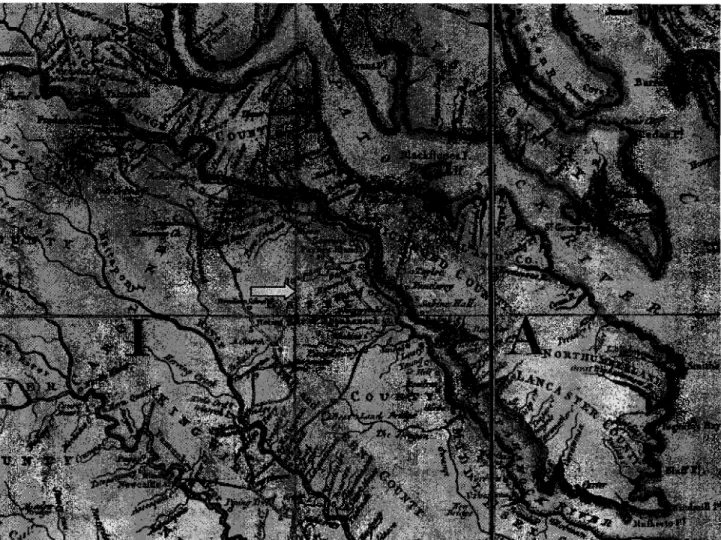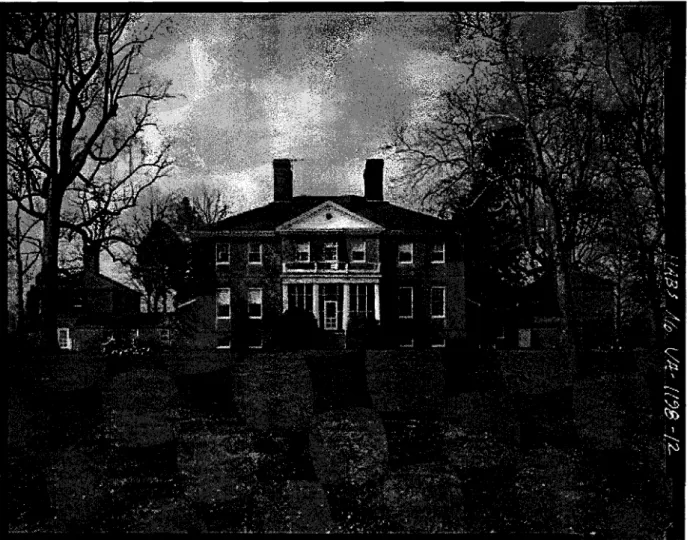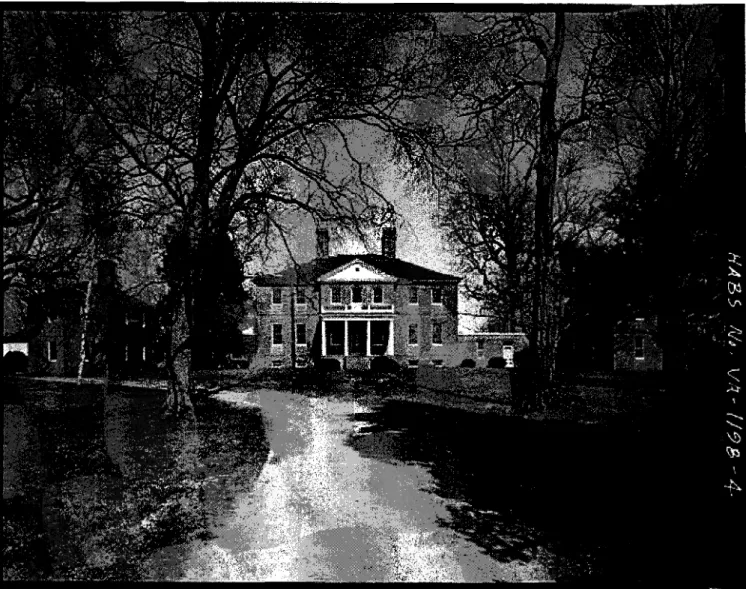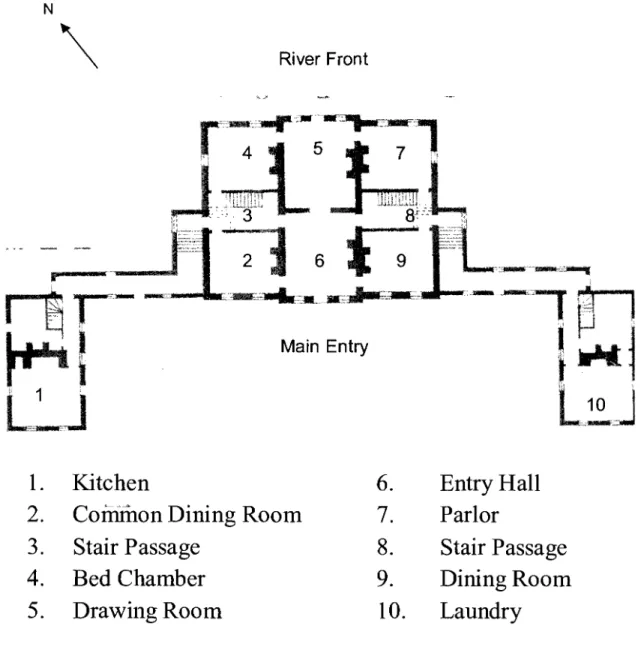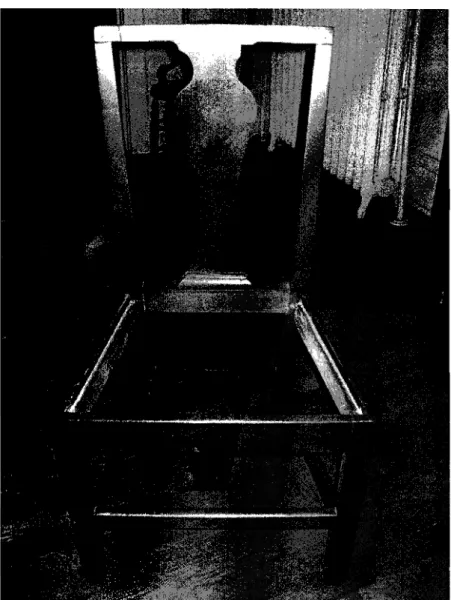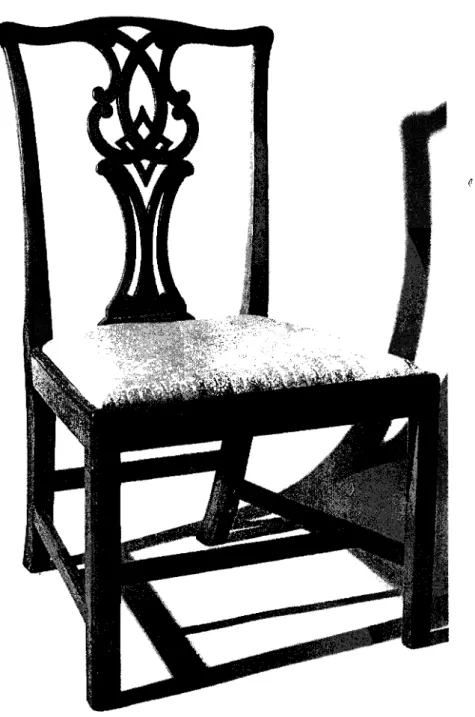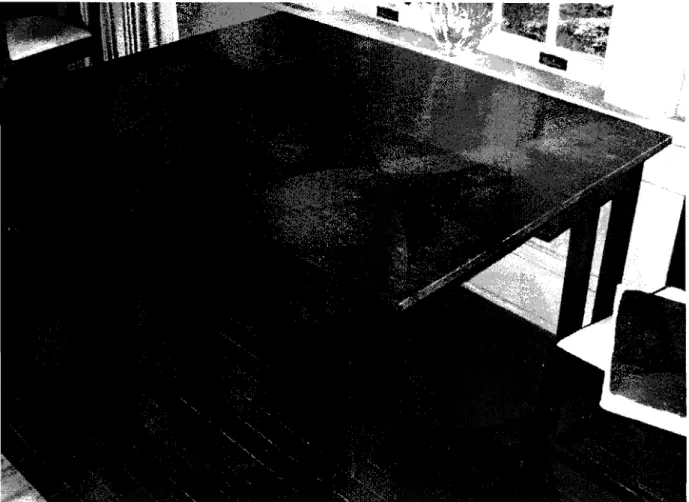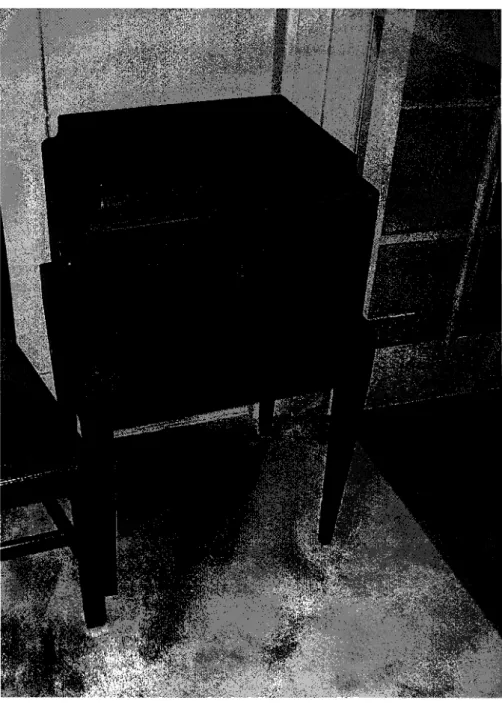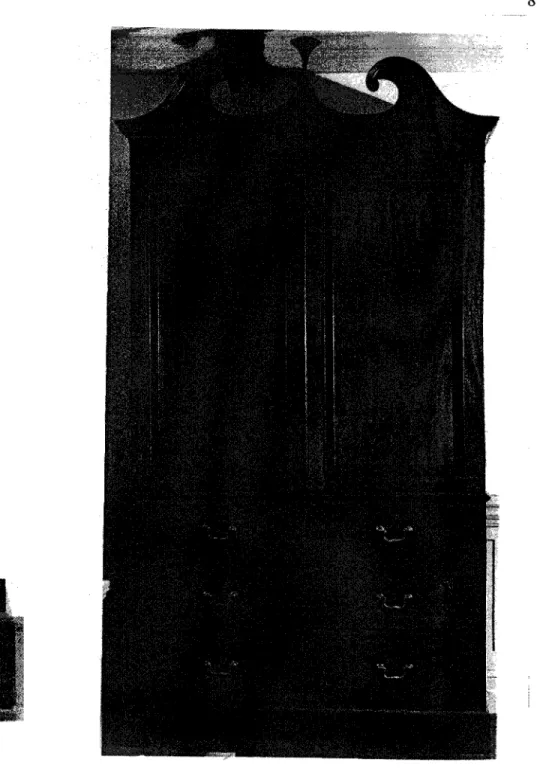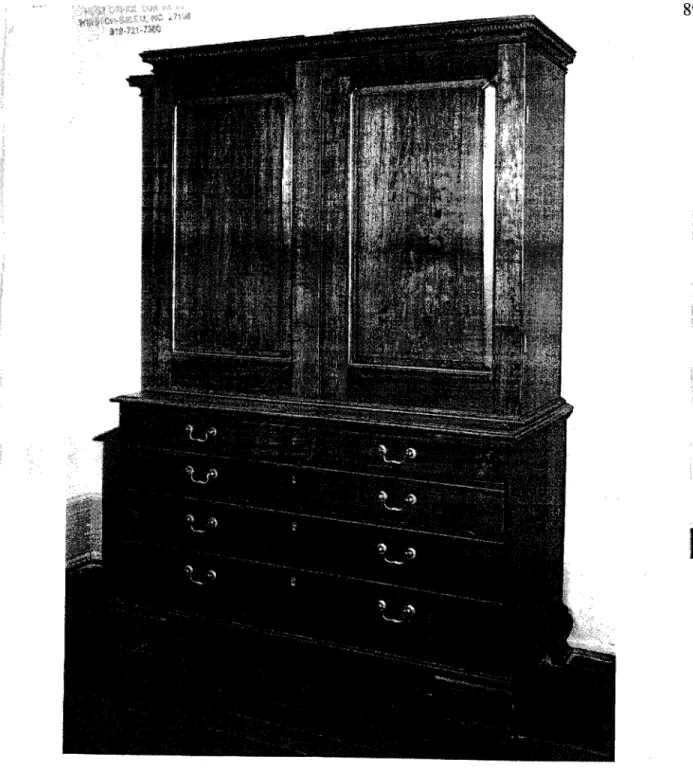Essex County, Virginia, 1760-1800
Christopher Harvey Jones
Submitted in partial fulfillment of the requirements for the degree
Master of Arts
in
the History of Decorative Arts Masters Program in the History of Decorative ArtsThe Smithsonian Associates And
Corcoran College of Art
+
Design 2006Christopher Harvey Jones
All Rights Reserved
List of Illustrations 11
Acknowledgments IV
Introduction 1
Chapter One - Robert Beverley -- Colonial Gentleman 5
Chapter Two - Choices and Constraints 19
Chapter Three - Blanc!field 28
Chapter Four - Conspicuous Consumption -- English Furniture at Blanetfield 42 . Chapter Five - American Pragmatist -- Virginia Furniture at Blanetfield 53
Conclusion - Robert Beverley -- American 69
Bibliography 72
Appendix One 77
Illustrations 80
List of Illustrations II
Acknowledgments IV
Introduction 1
Chapter One - Robert Beverley -- Colonial Gentleman 5
Chapter Two - Choices and Constraints 19
Chapter Three - Blanctfield 28
Chapter Four - Conspicuous Consumption -- English Furniture at Blan4field 42 . Chapter Five - American Pragmatist -- Virginia Furniture at Blan4field 53
Conclusion - Robert Beverley -- American 69
Bibliography 72
Appendix One 77
Illustrations 80
Figure One -- Essex County, Virginia, 1755, A New Map of the Most Inhabited Part of Virginia ...by Thomas Frye and Peter Jefferson, Detail, Library of Congress.
Figure Two -- Blandfield, East (River) Front, Historic American Buildings Survey Photograph, Ca. 1983, Library of Congress.
Figure Three -- Blandfie1d, West (Entry) Front, Historic American Buildings Survey Photograph, ca.1983, Library of Congress.
Figure Four -- Conjectural Floor Plan, Blandfie1d, Essex County, Virginia.
Figure Five -- Side Chair, Solid Splat, Mahogany (?) England, Ca. 1750 - 1775, Private Collection, Author Photograph.
Figure Six -- Side Chair, Diamond Splat, Walnut, England, Ca. 1750 - 1785, Private Collection, MESDA Photograph.
Figure Seven -- Dining Table, Walnut, Yellow Pine Secondary, Virginia, Ca. 1775, Private Collection, Author Photograph.
Figure Eight -- Wine Case, Mahogany, England, Ca. 1780, Private Collection, Author Photograph.
Figure Nine -- Linen Press, Arched Pediment, Mahogany, Virginia, Ca. 1775, Private Collection. MESDA Photograph.
Figure Ten -- Linen Press, Walnut, Virginia, Robert Walker, Ca. 1760 - 1777, Private Collection, MESDA Photograph
Figure Eleven -- Linen Press (One of a Pair), Walnut, Virginia, Ca. 1760 - 1777, Robert Walker, Private Collection, MESDA Photograph.
Figure Twelve -- Linen Press, Triglyph Frieze, Yellow Pine, Virginia, Ca. 1780 - 1800, Private Collection, Colonial Williamsburg Photograph.
Figure Thirteen -- Tea Table, Spiral Turned Column, Mahogany, Virginia, Ca. 1750
1770, Private Collection, Colonial Williamsburg Photograph.
Figure Fourteen -- Tea Table, Pointed Pad Foot, Black Walnut, Virginia, Ca. 1755 1770, Private Collection, Colonial Williamsburg Photograph.
11
Figure One -- Essex County, Virginia, 1755, A New Map of the Most Inhabited Part of Virginia ...by Thomas Frye and Peter Jefferson, Detail, Library of Congress.
Figure Two -- Blandfield, East (River) Front, Historic American Buildings Survey Photograph, Ca. 1983, Library of Congress.
Figure Three -- Blandfield, West (Entry) Front, Historic American Buildings Survey Photograph, ca.1983, Library of Congress.
Figure Four -- Conjectural Floor Plan, Blandfield, Essex County, Virginia.
Figure Five -- Side Chair, Solid Splat, Mahogany (?) England, Ca. 1750 - 1775, Private Collection, Author Photograph.
Figure Six -- Side Chair, Diamond Splat, Walnut, England, Ca. 1750 - 1785, Private Collection, ME SDA Photograph.
Figure Seven -- Dining Table, Walnut, Yellow Pine Secondary, Virginia, Ca. 1775, Private Collection, Author Photograph.
Figure Eight -- Wine Case, Mahogany, England, Ca. 1780, Private Collection, Author Photograph.
Figure Nine -- Linen Press, Arched Pediment, Mahogany, Virginia, Ca. 1775, Private Collection. MESDA Photograph.
Figure Ten -- Linen Press, Walnut, Virginia, Robert Walker, Ca. 1760 - 1777, Private Collection, MESDA Photograph
Figure Eleven -- Linen Press (One ofa Pair), Walnut, Virginia, Ca. 1760 - 1777, Robert Walker, Private Collection, MESDA Photograph.
Figure Twelve -- Linen Press, Triglyph Frieze, Yellow Pine, Virginia, Ca. 1780 - 1800, Private Collection, Colonial Williamsburg Photograph.
Figure Thirteen -- Tea Table, Spiral Turned Column, Mahogany, Virginia, Ca. 1750
1770, Private Collection, Colonial Williamsburg Photograph.
Figure Fourteen -- Tea Table, Pointed Pad Foot, Black Walnut, Virginia, Ca. 1755 1770, Private Collection, Colonial Williamsburg Photograph.
II
Figure Sixteen -- Side Chair, Trilobate Foot, Cherry, Virginia, Ca. 1760 - 1775, Private Collection, Colonial Williamsburg Photograph.
Figure Seventeen -- Side Chair, Carved Ribbon Splat, Walnut, Virginia, Ca. 1760 - 1780, Private Collection, MESDA Photograph.
Figure Eighteen -- Arm Chair, Vertically Pierced Splat, Walnut, Virginia, Ca. 1785 1800, Private Collection, Colonial Williamsburg Photograph.
III
preparation and editing of this work as well as for his inspiration and direction in my study of American furniture. I also wish to thank Ronald L. Hurst who originally suggested the topic and generously shared his knowledge and resources. This research would not have been possible without the assistance and kind encouragement of
descendents of Robert Beverley who shared with me family papers and allowed access to furniture from Blandfield in their private collections. Their support is gratefully
acknowledged. Any errors in fact or in interpretation are, of course, my sole responsiHity.
IV
Robert Beverley's world was profoundly and radically different from that of his father or grandfather, as would be the world his generation would leave for the next. His world was shaped by powerful forces over which he had varying de grees of control; at one level, Robert Beverley was a father and planter, raising his family, managing his fields, and participating in his church and community at the fringes of the great British Empire that was just coming into its ascendancy. At another level he was one of the wealthiest and potentially most influential members of a well educated, economically and socially elite class aspiring to power in an important region of that empire, a region that would during his lifetime assert its independence from the control of Crown and
Parliament!. Robert Beverley's immediate world was also shaped by the economic realities of the tobacco dominated agricultural system of the Chesapeake Tidewater, the broad rivers and bay opening into the Atlantic that largely eliminated the need for centralized ports and thus urbanization, and the mercantilist economic philosophies that guided British imperial policy that linked planters more directly to London than to many of their neighbors. Individually, his life would be shaped by his conservative outlook and a deep reluctance to challenge the established political and economic structures that had benefited his family for generations.
When Robert Beverley returned to his native Virginia from England in 1761 to claim his inheritance, he entered a world of paradoxes. The wealth that placed him in the
I Jackson T. Main, "The One Hundred," William and Mary Quarterly, Ser. 3, Vol. 11, No.3 (July 1954), 354 -384. Robert Beverley ranked among the five wealthiest men in Virginia, holding nearly 50,000 acres ofland scattered over eight counties. His almost 600 slaves were distributed among five counties with working plantations.
fIrst ranks of Virginia's colonial society was, however, insufficient to completely relieve the necessity of tending his affairs or elevate him beyond the status of provincial upstart in the eyes of European aristocrats. As one of the wealthiest men in North America, Robert Beverley would be chronically starved for cash and trapped within a trading system that rendered his purse and pride dependent on the merchants of London, Glasgow and Liverpool who controlled his credit, the sale of his tobacco, and access to the consumer goods he desired. As one of the region's largest landowners, he would find himself tied to the ineffIcient system of agriculture that rapidly depleted the land's fertility and demanded that new fIelds be constantly procured and cleared. While the system of chattel slavery that he professed to abhor had almost completely supplanted indentured servitude by his lifetime, it would provide Beverley with the manpower required by the labor intensive tobacco culture. 2 Along with the moral dilemma it presented, this perverse institution would also saddle him with the high costs of supporting large numbers of slaves whose value was reduced as less labor intensive wheat replaced tobacco as the century ended.
Neither Tory nor revolutionary, Robert Beverley chose to withdraw in the face of the political and military turmoil surrounding the breakup of the British Empire in North America. The legal training that reinforced his preference for reasoned discourse, rational
2 Beverley to Edward Athawes, 11 July 1761. Letterbook of Robert Beverley, Library of Congress, Manuscript Division, Washington, DC. The most well known of these Letterbook compilations of Beverley's correspondence is in the collection of the Library of Congress. It is referred to hereafter as Letterbook, WC. The letters were written in several hands. Possibly these copies were made as exercises in penmanship and as a part of their broader education by various Beverley children or by a secretary.
They are generally chronologically arranged from 1761 - 1800. Other Letterbooks, similar to the volume held at LaC, including some correspondence ca. 1745, by Robert's father, William, and son, Robert, Jr., extending well into the nineteenth century, are held privately by descendents of Robert Beverley. These sources are referred to hereafter as Letterbook, PRVT. The author is very appreciative of the access granted by family members to these documents and to their collections offurniture from Blandfield.
Miscellaneous papers relating to Robert Beverley and the Beverley family are also held by the Virginia Historical Society and the University of Virginia.
analysis and calculated compromise were no match for the passion for liberty, thirst for independence and the economic self interest that motivated many of his peers towards creation of a new government. In the early stages of the conflict, a voice for
compromise and reason, Beverley argued that the ties that bound the colonies to England were far greater than the issues that separated them, but failing to make his voice heard he withdrew. "I have always hated commotions," he wrote as war approached, "[and] I dread Innovations. They are generally carried on by bloodshed + very frequently end in Tyranny.,,3 Focusing his attention on his domestic affairs, he oversaw the completion and furnishing of his Essex County, Virginia, home known as Blandfield, and limited his role in public affairs during the Revolutionary period to that of a self-proclaimed
"sorrowful spectator ofthese tumultuous times." 4
The great majority of what we know of how Robert Beverley was shaped by the powerful forces at work in his world is revealed through his surviving Letterbooks, by his great home, Blandfield, and the furnishings with which he chose to surround himself.
From these resources Robert Beverley emerges as a unique individual and escapes the stereotype of a southern planter, but his Iegacy of correspondence, home and furniture also add a great deal of texture and nuance to our picture of the eighteenth-century Virginia gentry and their ambitions. His dialogues with agents, friends and family, his orders detailed in his Letterbooks, his estate inventory, Blandfield preserved by ten generations of Beverleys and today by the Wheat family, and the surviving furnishings, allow a comprehensive consideration of Robert Beverley, his home and its furniture. This work will seek to incorporate these three elements, Letterbooks, house and furniture, in
3 Beverley to Athawes?, ND c. 1775. Letterbook, LOC.
4 Beverley to Backhouse, July 12, 1775, Letterbook, LOC.
an integrated study of Beverley and the sources of furniture for Blandfield. It will provide new documentary evidence regarding the specific forms, styles and origins of furniture he acquired that will allow for a more accurate assessment of Robert Beverley's patterns of consumption and the choices of furniture available to him in the Virginia Chesapeake and give a better picture of life in that time.
Chapter One - Robert Beverley -- Colonial Gentleman
"I have an ample Fortune, and can be happy in the enjoyment of that, and an endearing Family. I ask no further Favour of my Country than the quiet Possession of it.. ..,,5
Robert Beverley's forbearers had seized the opportunities offered through politics, patronage, high risks and hard work in the often turbulent years in Virginia between the arrival of his great-grandfather in 1663 and his birth in 1740.6 Known as Major
Beverley, or "the immigrant," the first Robert Beverley (ca.1635-1687) to reside in Virginia had been born in Hull, England, and seems to have received some education, including training in the law. Settling south of the Rappahannock River in what became Middlesex County, Virginia, he rapidly acquired large tracts of land and became a man of consequence, holding a variety of posts in the colony including acting attorney general.
Married three times, Major Beverley sent his sons Peter, Robert and Harry to England to be educated. Building upon the advantages gained through their educations and the benefits flowing from a wealthy and influential father, the sons and their offspring
5 Beverley to Fitzhugh, July 20, 1775, Letterbook, LOC.
6 Information on the Beverley family's history and genealogy is drawn primarily from the Dictionary of Virginia Biography, John T. Kneebone, ET. AI., editors, (Richmond, Library of Virginia, 1998), Vol. 1, Brent Tarter, "Major Robert Beverley, (1635-1687)," Magazine of Virginia Genealogy, Volume 31, No.
3, (August 1993), John McGill, The Beverley Family of Virginia, (Columbia, SC, R. L. Bryan & Co.
1956), Worthington Chauncey Ford, "Some Letters of William Beverley," William and Mary Quarterly, Vol. 3, No4 (April 1895), "Diary of William Beverley of "Blandfield" During a Visit to England, 1750,"
Virginia Magazine ofHistory and Biography, Richmond, Virginia Historical Society, Richmond, Vol. 36, 1928.
represented one of "the most prominent families in Virginia in the early years of the eighteenth century." 7
Robert Beverley, Jr., (ca.1667- 1722) known as "the historian", consolidated and expanded the wealth and influence of the Beverley family in colonial affairs. Following his education in England, he married Ursula Byrd, the daughter of William Byrd
(ca.1652-1704), a union that allied two of Virginia's most important families. 8 Through his growing family and political network, Beverley was able to gain a series of influential and lucrative positions in government that added to his wealth and prominence. He was extremely active in the government and promotion of Virginia among British policy makers and prospective settlers and was the author of The History and Present State of
Virginia, In Four Parts, published in London in 1705. At Robert's death in 1722, all of his accumulated wealth and much of his political power were passed to his only son, William (ca.1696-1756). 9
Along with an inheritance of over 19,000 acres of land, William also received the benefits of an English education and upon his return to Virginia held a series of
governmental positions as a member of the House of Burgesses, Clerk of Essex County and a member of the Governor's Council. Taking full advantage of his political and financial resources, William Beverley acquired large tracts of land in Augusta County totaling some 118,000 acres and played an important role in the settlement of the Valley of Virginia. 10 His marriage to Elizabeth Bland, a daughter of Richard Bland of
7Kneebone, Virginia Biography, page 470.
8 Brent Tarter, "Major Robert Beverley (1635-1687)," Magazine of Virginia Genealogy, Vol. 31, No.3.
180-181.
9 Kneebone, Virginia Biography, 472. The History and Present State of Virginia, In Four Parts (1705), was the first published history of a British colony by a native of North America.
10 Kneebone, Virginia Biography, pages 477-478.
"Jordan's Point" in Prince George County, added an additional influential family to the Beverley sphere and produced at least three daughters and two sons. Their eldest son, John, died in November 1741 while attending school at a neighboring plantation leaving his brother Robert as the sole surviving son. II
Robert Beverley, the builder of Blandfield and subject ofthis work, was born at his father's estate in Essex County August 21, 1740. 12 (Figure One) Little is known of his youth, but as the only son of a prosperous, well connected Virginia family, he had little cause to question his own privileged status, the dominance of English culture in the tidewater Chesapeake, or the strong orientation towards London as the center of
economic and political power. Both his father, William, and grandfather, Robert "the historian," had been politically active on both sides of the Atlantic and had relied upon hierarchical relationships to gain and dispense patronage. Beverley's sense of self and his political and economic philosophies must have been influenced by his father's relationships with the powerful Fairfax family, the Speaker of the House of Burgesses, John Robinson, and his family's linkages to other prominent landowners in the colony including the Byrds, Randolphs, Fitzhughs, Carters and Lees.l3
Robert Beverley traveled with his father to England in 1750 where he was enrolled at Wakefield Grammar School in Yorkshire to begin his formal education.14 William Beverley recorded in a diary some of the details of this trip with his son and traveling companions who included a nephew, Robert Munford, who would also attend
II Some Letters of William Beverley, William and Mary Quarterly, Vol. 3, NO.4 (April 1895),233.
12 Kneebone, Virginia Biography, 473-474. Beverley Family, Rootsweb.
13 Kneebone, Virginia Biography, Vol. 2, 255-257. The Fairfax family was one of Virginia's largest landowners. IohnRobinson was the Speaker of the House of Burgesses 1738 -1765.
14"Diary of William Beverley of "Blandfield" During a Visit to England, 1750," Virginia Magazine of History and Biography. Vol. 34, (April 1928),27.
Wakefield, Col. John CarlyIe, a prominent merchant from Alexandria, and William Henry Fairfax. ls Among the notable events of this trip were visits by father and son to the town of Beverley in Yorkshire and the introduction of Robert to a variety of family friends and associates including a leading tobacco merchant, Edward Athawes. The familiarity of the letters to Athawes following Robert's return to Virginia, and later to Athawes' son, Samuel, suggest strong personal ties, and it is likely that Edward Athawes was something of a mentor and surrogate parent who oversaw young Robert during his decade in England.16
Robert Beverley was a student at Wakefield presumably from his arrival in England until 1757 when he was admitted to Trinity College Cambridge. He studied law at the Middle Temple and was called to the bar in February, 1761, but did not graduate and never seems to have practiced law.1? Although his father had died in 1756, Robert Beverley did not return to Virginia for five more years. He arrived home in the spring of 1761 and shortly thereafter began to record his correspondence in a series of Letterbooks.
His first letter, dated July 11, 1761, was directed to "Edward Athawes, Esq.," his friend and mentor, announcing his safe arrival in Virginia after a passage of nine weeks.I 8
He immediately followed in August with orders to be sent on the first ship for porter, ale, wine, beer and water glasses, and tailored britches, seemingly reconciled to "be content where I am at least three or four years + then, I hope, shape out a Residence more suitable
15 Diary of William Beverley, page 30. William Henry Fairfax was probably the owner of Belvoir in Virginia and a grandson of Thomas, 4th Lord Fairfax.
16 Diary of William Beverley, page 164. Upon his departure from England, Robert presented Athawes with a miniature portrait of himself, another indication ofa close relationship. Beverley to Athawes, Sept. 6,
1774, Letterbook, Wc. He later had this portrait copied for his wife, Maria. Little is known of Edward or Samuel Athawes. The Athawes, along with Backhouse, Bland and others were prominent English
merchants dealing in the Chesapeake tobacco trade.
17 Kneebone, Virginia Biography, 473-474. Email, 5/31/05, Adam Green, Assistant Archivist Trinity College, Cambridge to the author.
18 Beverley to Athawes, July 11, 1761, Letterbook, LOC.
to my Inclinations," although he complained to Athawes that "news is a very scarce article + amusement much scarcer.,,19 From his correspondence it seems clear that Beverley was ambivalent about his future; at one moment he seemed to anticipate a life in Virginia, at the next he declared that after settling his father's estate and securing his inheritance, he would quickly resume his life in England.2o The early letters deal primarily with resolving his father's affairs, the necessities of the tobacco trade and Robert's largely optimistic assessment of his financial prospects, which he anticipated would allow him to live a life of leisure in Great Britain. "I had much rather be an
Inhabitant of Britain upon [pounds] 500 anno than to blaze away here upon four times the sum," he declared in a letter to Athawes. The realities of the cyclical and difficult
business of growing tobacco intruded almost immediately, and Beverley admitted to Athawes that at least two years might be required for him to payoff his debts and
successfully organize his holdings while a third would provide the cushion he desired for a "short crop." 21
Only in his early twenties and with little experience in managing a large and complex enterprise, Beverley found the ftrst few years back in Virginia tumultuous both personally and fmancially. While measured in terms oflandholdings, he was extremely wealthy; he discovered that money was "scarce in [his] part of the country" and that maintaining a frustrating and personally demeaning level of credit with his English agents
19 Beverley to Bland, July 11,1761. Letterbook, LOC, Beverley to Athawes August 1761, Letterbook, LOC.
20 "Will of William Beverley, 1756," Virginia Magazine ofHistory and Biography, 297-301. After provisions were made for his mother during her lifetime and marriage portions provided for his sisters, Robert was made the heir to virtually all of his father's estate.
21 Beverley to Edward Athawes, 3 March 1762. Letterbook, LOC.
was an unavoidable evil if he wished to sustain the lifestyle of a gentleman.22 He had also experienced a failed and disappointing romantic foray of which he wrote to Athawes in October 1762, "The Excursion, which 1 made to Philadelphia was with a view of [mally fixing myself in my native country by becoming a married Man, but it seems adjudged highly necessary by Providence that we must not be gratified in every Pursuit in Life ... [but 1 remain] fully determined to bear this + every other Disappointment with Fortitude.,,23 By December his notion of returning permanently to England had again been challenged by a neighbor just across the Rappahannock at Sabine Hall whose charms inspired Beverley to write Bland "that before you receive this, 1 shall become a married man." Two months later, he announced to Bland that, "Since I last wrote to you, 1 have fixed myself in the Country by Marrying a daughter of Col. Landon Carter and flatter myself that 1 may render myself tolerably happy even in this Distant region.,,24 Beverley's marriage to Maria Byrd Carter (1745 - 1817) would be the catalyst for the construction of a new Blandfield to replace the house inherited by his father known by the same name and for a succession of orders that chronicle a rapid ratcheting up of his levels of consumption and expanding lifestyle.
With his decision to settle permanently in Virginia, Robert Beverley assumed his expected place in the life of Essex County, the principal local governmental entity, and in the Anglican church parish of St Anne's, where he served as a vestryman. "I am vastly in my Domestick way", he wrote Samuel Athawes in November 1763, "+ unless some
22 Beverley to Bland, Oct. 6, 1761, Beverley to Athawes, Nov. 18, 1763, Beverley to Bland, Dc. 17, 1763.
Letterbook, LOe.
23 Beverley did not identify the object of his affections in Philadelphia, only that "it was an Affair, which I most earnestly wished," but took a philosophical approach to his disappointing foray. It is one of the few references to Philadelphia in the Letterbooks, a city with which Beverley seems to have had very limited commercial or social contact. Beverley to Athawes, Oct. 27, 1762, Letterbook, LOe.
24 Beverley to Bland, Feb. 25, 1763, Letterbook, LOe.
accident should Disturb my Repose, I shall not alter my method of Life .. .I delight in my plantations and am a commenced farmer.,,25 His family's prominence and his legal training gained him appointment in 1764 as a Justice on the Essex County Court where he served until the outbreak of the Revolution.26 Beyond his official role, Robert
Beverley was an active participant in the area's business affairs but not markedly litigious in his approach to matters.27 The majority of his appearances in the Court's records involved debt collections, land sales or purchases and title matters that reflected the normal course of business. Beverley appeared as an interested party or appointed official in a range of other management matters of county life which the general court oversaw including the certification of warehouse measures, the construction of bridges and roads, and surveys. While Beverley accepted appointment to several official positions inc luding the Board of Visitors of the College of William and Mary, and as an officer in the county militia, and expressed interest in appointment to the Governor's Council, there is little record of his having been active in any of these roles.28 He seems not to have shared the aptitude or appetites of his ancestors for the risks, rewards and rough and tumble of politics beyond his immediate community and approached public life with a degree of ambivalence.
The course of his adult life and his place in history were largely the product of Robert Beverley's decision to remain passive during the American Revolution which
25 Beverley to Samuel Athawes, 18 Nov. I763.Letterbook LOC.
26 Kneebone, Virginia Biography, 474.
27 Based on examination of the Order Book for the General Court for Essex County for the years 1760
1800. Microfilm, Library of Virginia.
28 He indicated his interest in serving on the Governor's Council to Carter. See Letters of Robert Beverley to Landon Carter, Virginia Historical Society. Beverley was elected to the Virginia House of Delegates in
1780, but it is unclear ifhe took the seat. He was selected as member of the Board of Visitors of the College of William and Mary in 1775 - Va. Gazette, 2/17/1775. "At a meeting of the Governors and Visitors Robert Beverly Esquire of Blandfield in Essex was chosen a member ... " but it is not clear ifhe ever took an active role in the institution's affairs.
flowed from his deep reservations concerning the independence movement and reluctance to countenance violence with England - attitudes shared by numerous contemporaries?9 In addition, Beverley was deeply distrustful of the role that personal ambition played in politics and worried that the ambitions of the movement's leaders rather than idealism motivated the rebellion. Beverley feared that the appeal of these leaders to the emotions of their followers prevented rational consideration of the issues that divided Crown and colonies, but he recognized in a letter to William Fitzhugh that,
"Self-interest and Want ofCandoUf on both Sides" contributed to the impasse.3o The tone of the controversy, he concluded, rather than the essential issues, stood in the way of a resolution. While he acknowledged the justice of many of the grievances of the
colonists, the need to protect their inherent rights as Englishmen, and was a supporter of the non-importation pacts, Beverley abhorred the country's "unhappy State on Anarchy and Misrule," and could not bring himself to support armed resistance to England. 31 "I
29 Linda Colley, Britons, Forging the }fation 1707 - 1837, (New London, Yale University Press, 1992), Reflecting the confusion and uncertainty of the times, it was estimated that the population of the colonies was approximately one third revolutionary, one third Tory, one third undecided or neutral. See also Kevin Phillips', The Cousins' War, John Shay, A People Numerous and Armed, Jack Greene, The Blackwell Encyclopedia o/the American Revolution and the work of Ronald Hoffman for the divisions within early American society.
30 Beverley to Fitzhugh, July 20, 1775, Letterbook, Lac. William Fitzhugh was a nephew of Landon Carter and was active in Virginia politics.
31 Beverley to Athawes, Sept. 6,1774, Beverley to Backhouse, July 12, 1775, Letterbook, Lac. These letters and Beverley's letter to Fitzhugh of July 20, 1775, Letterbook, LaC, are the most thorough presentations of his not altogether consistent political views. His positions are analyzed by Robert M.
Calhoon in "A Sorrowful Spectator of These Tumultuous Times" in The Virginia Magazine 0/History and Biography, Vol. 73, January 1965, pages 41-55. The non - importation agreements and associations between the colonies were designed to force Parliament to rescind the taxes imposed on trade and other activities through the Grenville Acts 1764, Stamp Act 1765 and Townshend Revenue Act 1767. The more organized Continental Associations of 1774 were the precursors of the post war Confederations and led to a reduction of over 90% in the value of English imports to the colonies in 1774-1775. Mark M. Boatner, Encyclopedia o/the American Revolution, New York, McKay, 1966, pages 47,810. The Virginia Gazette July 21, 1774, recorded Beverley as a member of the Essex County committee to send aid to Boston,
"Resolved that a subscription be set on foot for raising of provisions for the relief of the poor of Boston who now suffer by the blocking up their ports and that Robert Beverly, John Lee, Muscoe Garnett,
... charter a vessel to carry it to Boston". On Jan. 5, 1775 the Gazette listed Beverley as a member of the County committee to support the association agreements and resolutions of the Continental Congress. But
have found the current strong and shall not oppose it," he explained to Fitzhugh and concluded neutrality would be the only tolerable policy.
With his decision by the outbreak of war to largely withdraw from public affairs, Robert Beverley seems to have limited his travel and contacts and devoted the remainder of his life to the management of his family affairs and estates. His Letterbooks and other surviving correspondence offer insight into the significant and routine events of a life dominated by the demands of tobacco, multiple children and challenges of the
tumultuous times. Beverley chronicles the seasonal issues relating to agriculture in general and in particular the vicissitudes of raising tobacco, a crop he complained was
"more liable to accidents than any other plant in the World.,,32 Beverley continued to depend upon tobacco as his principal crop in the 1780s, and virtually every entry in his Letterbook dealt to some extent with the prices, condition or prospects for the crop. Only gradually, and years after many of his peers, Beverley shifted a significant portion of his resources from tobacco to the growing of wheat, which he eventually recognized as a more predictable source of revenue and as a means of lessening his dependence upon commerce with London. Marketable either in the American market or Europe, in the last decades of the eighteenth century wheat had spurred significant economic development in the Chesapeake, particularly in Baltimore, and had increased consumers' income and the range of items available. As Beverley wrote testily to John Backhouse in 1795
in letters to Landon Carter, Beverley indicated grave reservations concerning non-importation, which injured the merchants who had relied on the word and honor of the planters, and the dire consequences of limiting trade. Despite his misgivings Beverley supported the non-importation pacts and frequently cautioned his agents that he "would be very unwilling to violate our associations in the most trifling instance" and specified that they should not fill his orders unless "the differences should be adjusted." He also believed that restricting trade with Great Britain would lead to an increase in American manufacturing and decrease the level of economic dependence. Beverley to Athawes Sept. 6, 1774, Beverley to
Backhouse, Dec. 19, 1774, Letterbook, LOC.
32 Beverley to Backhouse, July 1790, Letterbook, Wc.
concerning his dissatisfaction with the merchant's fulfillment of an order, "I can barter my grain [here] for what I may want.,,33 The region's economy and Beverley's
circumstances had changed, and by the 1790s Beverley had reached the point that he could state, "I have Established a Resolution never to run in debt in Europe again.,,34
Beverley was isolated, to a degree, by the remote location of Blandfield, the size of his land holdings, the sparseness of population and the difficulties of travel, which resulted in a commercial universe that seems to have been largely confmed to the towns in the vicinity, Tappahannock, Williamsburg and Fredericksburg. Over time, as he became more involved in the management of his scattered plantations, references in his Letterbooks to travel to Richmond, Petersburg, Staunton and Culpepper become more frequent, but there is little evidence of sustained business or family relationships beyond the tidewater and central piedmont portions of Virginia. 35 Just as his business horizons were limited, Beverley also seems to have had unusually limited personal interaction in the famously social Chesapeake?6 Beverley receives only rare mention in the papers of
33 Beverley to Backhouse, Jan. 1, 1795, Letterbook, PRVT.
34 Beverley to Dunlap, Glasgow, Jan 1, 1795, Letterbook PRVT.
35 In this regard it is notable that Beverley indicated frequently in the 1780s and into the 1790s that he did not have regular business in Philadelphia or Alexandria and made commercial arrangements in these towns on a case by case basis. He noted that he rarely encountered anyone traveling to Norfolk. Beverley to Burke, Jan 25, 1793. Beverley to Easton, July 22, 1793, Letterbook, Lac. After the Revolutionary War as trade and credit were gradually reestablished, Beverley's Chesapeake network expanded somewhat.
References to Norfolk as a trans-shipment point appear, and Baltimore emerges as a city to which he directed goods, shipped his non tobacco crops, notably wheat, and from which he obtained a variety of goods such as bar iron and cat gut for his clock weights. Similarly, Richmond, Petersburg, and Dumfries to the west seem to have taken on increased importance for Beverley although his commercial affairs seem to have centered in Fredericksburg.
36Robert Beverley appears infrequently if at all in the recorded correspondence of his peers. A survey of surviving published papers ofhis contemporaries gives no indication that any of the political leaders of his generation considered him or his views of any particular significance. There is no mention of Robert Beverley or Blandfield in the published papers of George Washington, (although his son, Robert, may have visited Mount Vernon), James Madison, George Mason, James Momoe, William Byrd, Patrick Hemy, John Carroll, William Lee, and John Marshall, all of whom likely knew Beverley or of him Only Thomas Jefferson seems to allude to him briefly in a 1789 letter to William Short in which he notes seeing a
"Robert Gaines Beverley selling off all for debt" mentioned in the Virginia newspapers and asks of Short
"if this is the Tory and head of the family."
his peers and only occasional notice in the diary of his irascible father-in-law and neighbor, Landon Carter.37
Even though he had withdrawn from public life beyond his immediate
community, Beverley continued a lively interest in reading of the affairs of the day and frequently encouraged his correspondents in London to supply a steady stream of current newspapers and magazines. His letters combine his commentary on colonial, and
subsequently American affairs, and European politics with his instruction, inquiries and entreaties regarding business issues surrounding the pricing and marketing of his crops and the administration of his accounts. The correspondence reveals Beverley's growing disdain for continental conflicts and his gradually increasing optimism that an
independent America might offer opportunity and prosperity for his sons and daughters.
Beverley's papers vividly reflect the great degree of uncertainty which surrounded life in the Chesapeake as the new American government sought to organize itself, and both individuals and businesses suffered from the constant interruptions of European wars, trade embargoes and the unpredictable nature of communication, commerce and travel in period.
Maria and Robert had ten sons and six daughters beginning with William in 1763 followed by births at regular intervals until 1786 and the arrival of their last child,
Harriet. The size of the Beverley's family and the need to provide appropriately for each of his children were matters of significant concern for Robert Beverley as he grew older
37 Jack Greene, Ed. The Diary of Colonel Landon Carter ofSabine Hall, 1752 - 1778, (Charlottesville, University Press of Virginia, 1965). Consistent with Carter's nature, most of his observations regarding Beverley were unflattering and suggest Beverley found little in the way ofcomradery from Maria's father or called frequently at Sabine Hall. A group ofletters from Beverley to Carter at the Virginia Historical Society that discuss family affairs, agriculture and business as well as some of Beverley's views on the day's political and economic issues add further depth and dimension.
and placed increasing constraints on his affairs. "The largeness of my family compels me to observe a strict economy in the maintenance of my children," he warned a Virginia merchant, and similar cautionary comments concerning his finances along with
complaints concerning prices pepper his correspondence.38 Beverley further indicated his concern for his financial circumstances and a sense of pragmatism towards his children in a letter to William, then studying in England, which foreshadowed their later difficulties over money. "It is not to be supposed," he wrote William in 1787, "that the [mances of a Virginia planter are to vie with those of a British nobleman especially a Virginia planter with Ten children... consider yourself... [one] who never will be in possession of a fortune to enable him to be anything else [but] genteel company....,,39
Beverley made sustained efforts to gain practical experience for his younger sons and sought positions for them with Virginia-based merchants and subsequently supported their efforts to establish general stores in Culpepper and Tappahannock.4o Not surprisingly, given the size of his family and complexity of his holdings, his ef~ortsto establish career opportunities or satisfactory economic circumstance for each of his offspring were not wholly successful. He would eventually and reluctantly agree to William's decision to renounce his links to Virginia and reside in England, but the strained relationship and financial settlement, which his eldest son found inadequate, eventually led to estrangement and "much litigation and strife.,,4J Robert, the second son also educated in England, did return to Virginia to assume management of lands
38 Beverley to Montgomery, May 28, 1789, Letterbook, LOC.
39 Beverley to William Beverley, Oct. 7, 1782. Letterbook LOC.
40 Carter Beverley and Byrd kept store in Culpepper and Tappahannock before giving up their endeavors in the mid 1790s. Letterbook, PRYr.
41 Virginia Magazine ofHistory and Biography, No. 21, 213.
transferred by his father, and Beverley would subsequently grant tracts of land or otherwise provide an inheritance for each of his children.42
Apparently, his health was in decline by the mid 1790s and Robert Beverley devoted a good deal of the last years of his life to arranging his estate. In March 1793, he drew up a detailed and carefully constructed will in which he sought to "display the strictest impartiality to all my children" which he felt had guided their relationships.43 After providing fully for Maria's welfare during her lifetime through lands, rents and slaves, he stipulated that she should receive all of the furniture, but authorized her to disperse it at or before her death to such of their children as she thought proper.
Beverley arranged his lands to be divided among his sons with Robert receiving the two most prominent plantations, Blandfield and the nearby tract known as "Gray's.'44 The approximately 600 slaves were apportioned between Maria and the various children through a complex formula, and careful provisions were made for the payment of any remaining balance that might be owed to his estranged eldest son, William, at Beverley's death.45
Over the ensuing seven years, Beverley added nine codicils as sons came of age, daughters were married and settlements made, and changes in his land holdings occurred.
The last of these codicils, dated January 24, 1800, just a few months before his death,
42 Robert received the largest share of the family holdings and eventually succeeded his father as master of Blandfield. Robert lived briefly in Georgetown in the early 1800's where he built the house known today as Dumbarton Oaks.
43Last Will and Testament of Robert Beverley of Blandfield, March 9, 1793 with codicils, presented into Court April 21, 1800. Essex County Will Book, Microfilm, State Library of Virginia. Appendix One presents a transcription of the furniture listed in the estate inventory that accompanies the will.
44 Grays was a tobacco plantation owned by Beverley that was also in Essex County. Other plantations were known as Chase Plantation in Caroline County, Park Plantation in King and Queen County, and New Design, Poplar and Little Fork Plantations in Culpepper County. Vanessa E. Patrick, Architectural
Historian, Blandfield Essex County, Virginia, An Interim Report on Phase One Documentary Research, June 1983, Typescript manuscript, research files, Colonial William;burg.
45 Beverley also stipulated that the slave Harry, who had attended him for twenty years, should be freed
"upon the death of his mistress" and granted him seventy acres ofland in Essex along with the necessary implements to farm Since Maria lived illltil 1817, it is questionable what benefit Harry may have received from this bequest.
concerned the disposition of his stocks of brandy. It began: "Willing to avoid every kind of misunderstanding in my Family..." and suggests a dying man whose possessions had already begun to be quarreled over. Robert Beverley's death on April 12, 1800, at Blandfield received scant notice beyond his family and a brief obituary in the Richmond Gazette which read: "Died, at Blandfield, on the 12th instant, ROBERT BEVERLEY, Esq, in the 60th year of his age, after a long and painful illness which he bore with uncommon fortitude and patience. He has left behind him a very large family to lament the loss of one of the best of fathers and the best of men.',46
46 The Virginia Gazette and General Advertiser, Tuesday April 18, 1800. MESDA microfilm
Chapter Two - Choices and Constraints
"Non Importation ...may be attended by substantial benefits, for although the
inconveniences under wch we shall at fIrst labor will be very great, yet it is notorious with the assistance of the Emigrants from G.B., we shall be able very soon to Establish Manufacture, for our immediate support ....47
Having sketched the broad outlines of Robert Beverley's life, including the difficult political decisions that gave rise to his reputation as a Crown sympathizer, if not an outright Tory, it is possible to consider some aspects of the economic and social contexts in which he made the decisions concerning the furnishings he desired for his home. Beverley was certainly well aware of the much discussed forces shaping his world; the policies of Parliament and progression towards war with Great Britain, the cycles of the agricultural markets, and the desire of the colonies for increased self sufficiency. On an immediate and practical level, his choices were constrained by non
importation pacts among the colonies, extreme swings in tobacco crops and prices, unreliable transport and communications, and the slow growth of towns in the
Chesapeake and along the fall line of Virginia's rivers. Other powerful forces such as the fIrst rumblings of industrialization, the dramatic increases in consumption, and the
diminishing viability of the slave economy, were influences that were likely vaguely sensed, but much less recognizable or understandable to Beverley or his contemporaries.
47 Beverley to Athawes, Sept. 6, 1774, Letterbook, LOC. Notorious is used in the sense of a fact widely known but without the pejorative implication.
Whether recognized or not, all of these factors and others, shaped the possibilities, perceptions, and the goods and choices available to Robert Beverley as he went about furnishing Blandfield.
Beverley's peers, the great Tidewater planters who dominated Virginia society in the eighteenth century, represented between three and ten per cent of white heads of household. 48 By the middle of the century distinct gentry families were emerging and their growing wealth allowed them to begin to replace the modest wooden family houses built by their ancestors with the elegant Georgian mansions that transformed. the banks of the Chesapeake's estuaries. Beverley, like the Tayloes, Lees, Carters and others created great homes such as Mount Airy, Menokin and Nomini Hall that characterized this movement toward grandeur, social differentiation and symbolic display. 49 Growing along with their wealth and homes was the ambition to live like English gentry, and the leading gentlemen of Virginia indulged themselves with a wide range of consumables and furnishings to the point that in 1736 an English visitor arriving at nearby Yorktown wrote that, "You perceive a great Air of Opulence amongst the inhabitants, who have some of them built Houses equal in Magnificence to many of our superb ones at St.
James ....,,50 Blandfield, built thirty years later on the eve of the Revolution, did not represent the beginning of a trend, but rather approached the culmination of this era's notion of the great home as an embodiment of gentility, and the apogee of its
development along the Chesapeake in terms of scope, grandeur and evolved interior design. The floor plan, room design and dimensions, patterns of access and functional
48 T. H. Breen, Tobacco Culture, The Mentality ofthe Great Tidewater Planters on the Eve of Revolution, (Princeton, Princeton University Press, 2001), 32 -37.
49 Breen, Tobacco Culture, 32 -37.
50 London Magazine, July 1746, quoted in Breen, Tobacco Culture, 37.
designations of the spaces that Beverley integrated into his plan for Blandfie1d reflected the increasingly complex standards of gentility developing in the late eighteenth century.
Blandfield, Robert Beverley's "great Plantation Manor," would, he hoped, provide a genteel seat for the Beverley family that reflected their refmement, accomplishments and status, and bolster the authority of the family and its patriarch.51
Concepts of gentility have been deeply intertwined in debates concerning the causes and effects of the development of material culture in the Chesapeake. Expanding notions of gentility are an important element in the framework in which many modem scholars have addressed the explosion of consumerism within British American and elsewhere. 52 The estate inventory research of Lorena Walsh, a leading authority on material culture in the Chesapeake, has shown that during Beverley's lifetime the range of domestic goods with which gentry and aspiring gentry wished to surround themse lves
"exploded."53 The great increase in the array of these amenities facilitated a style of living that supported a distinct and identifiable upper class lifestyle. Luxuries that would have been unimaginable a generation or two previously, including larger living spaces,
51 Dell Upton, Holy Things and Profane, (New York, Architectural History Foundation, 1986),206 - 209.
52 Much research has been undertaken and a great deal written beyond Walsh on the development of consumer society in the Chesapeake; frequently citing Beverley as an example. Nearly all is relevant in understanding Robert Beverley and the context in which he made his choices, and, while a comprehensive analysis of this research falls well beyond the scope of this work, several seminal studies provide important insight concerning Beverley. Richard Bushman's identification in his TheRefinement ofAmerica of the growing consciousness of eighteenth-century elites ofthe power of material goods such as houses, furniture and gardens to distinguish themselves from other strata of society established an early framework for consideration of a growing consumer culture. Cary Carson expanded these concepts to explain the evolution of the most fashionable consumer goods into virtual badges of membership in self conscious, international consumer groups. Rhys Isaac has continued the analysis of Chesapeake society in his study of the Transformation of Virginia during the eighteenth century. Isaac analyzes houses and public buildings of eighteenth century Virginia as elements of a system through which the Chesapeake gentry solidified its power. See also Lois Green Carr and Lorena S. Walsh, "Changing Lifestyles and Consumer Behavior in the Colonial Chesapeake," in Of Consuming interest, Cary Carson, (Charlottesville, University Press of Virginia, 1996).
53 Lorena S. Walsh, "Urban Amenities and Rural Sufficiency: Living Standards and Consumer Behavior in the Colonial Chesapeake, 1643-1777," Journal ofEconomic History, Volume 43, Issue 1, (March 1983), 110.
increased levels of personal comfort and quality and quantity of decorative accessories rapidly became necessities for the genteel.54 The growing refmement of the Chesapeake gentry and their desire to differentiate themselves as a group was expressed in the internal stratification and external authority of the architecture of their homes and the objects with which they furnished the space.55 Walsh notes that such props as matched china place settings, mahogany chairs, tables, buffets and bookcases along with the appearance of coaches and carriages should be seen as indications of an affluent gentry eager to display and differentiate itself through material wealth.
Beginning with his very fIrst order, Robert Beverley's purchases from Virginia fit neatly into Walsh's description and provide ample evidence that he had fully embraced the English genteel lifestyIe with all its accoutrements. His early orders included a chariot (carriage), the outfitting and painting of which he described in great detail, livery for his servants and a wide range of ceramics, glass, cutlery and fme attire.56 In his instructions to his agents Beverley also frequently provided detailed descriptions and specified individual tradesmen that reveal a familiarity and intimate knowledge of the London shops indicative of an experienced consumer. "When I point out any particular Tradesman, (tho he may live at a distance)," he wrote Bland, "I desire you to purchase of him, because those whom I have employed are not concerned in the Exportation Trade +
54 Earlier Beverley generations had "nothing in or about his house but what is necessary." Carson, Of Consuming Interest, 64.
55 Isaac, Transformation, 73-75
56 Beverley's (excerpted) order for his chariot provides an example of the level of display and elegance he wished to achieve. "Mr. Page, The following directions I desire you observe with the utmost punctuality. I desire you make me a neat light post Chariot painted as my Phaeton, a light green upon silver, with three bulls heads upon the front & back, & one upon each side the lining to be light colored Cloth with a green &
white lace ...the front to be divided into two glasses instead as usual one ... The inside you must have neat brass rods with green silk curtains ... & also netting inside to put Ladies hatts ..." Beverley to Page, Nov.
1761, Letterbook, We.
of course the goods will be better + more to my own Inclinations.,,57 Robert Beverley with his great wealth, English education and prominent family represents a prime, if somewhat extreme example, of the degree to which the concept of gentility and the importance of material culture had been embraced by the Virginia planters. Evidence from his Letterbook correspondence, the elegance and social order of Blandfield, and the furniture displayed there testify to Beverley's enthusiastic embrace of the rituals and rites of gentility, and his efforts to replicate on the Chesapeake the most genteel lifestyle on the English model that his resources could provide.58
While Beverley and the other great planters of the Chesapeake probably came closer than any other group in British colonial America to the lifestyle of the English landed gentry, the British and European elites found them to be provincial, wanting in social origins, much too prone towards bourgeoisie materialism and tainted by a business mentality. 59 The new colonial gentry and the old European one were linked by an
increasingly international society but were set apart by the dissimilar realities of life. An acute awareness of this sense of provincialism, of physical and cultural remoteness from the mother country, is evident in Beverley's correspondence and was certainly a factor in driving his ambitious quest for displaying his refmement and a motivating force in his pursuit of a genteel lifestyle. 60 However unpleasant the concept, connotations or consequences of their ambiguous status, the Chesapeake planters were the relatively
57 Beverley to Bland, 10 Jan 1762. Letterbook, LOC.
58 Cary Carson, "The Consumer Revolution in America, Why Demand?' Of Consuming Interest: The Style ofLife in the Eighteenth Century, (Charlottesville, University Press of Virginia, 1994), 522 - 524.
59 Michael J.Rozbicki, The Complete Colonial Gentleman, Cultural Legitimacy in Plantation America, (Charlottesville, University Press of Virginia, 1998), 1-3.
60 Rozbicki, Colonial Gentleman, 77-78.
nouveau riche residents of a distant territory and were, in fact, culturally and physically isolated from the center of the British Empire upon which they were dependent.
The degree to which planters such as Beverley were isolated, the pace of introduction of consumer goods into the Chesapeake, the level of the self sufficiency experienced by planters, and the impact of these factors on the economic development of the region were important determinants in shaping Beverley as a consumer. The system of large plantations, the geography of the Chesapeake with its broad rivers linked to the sea and England, and the restrictive British mercantile system protecting her merchants and manufacturers clearly hindered the creation of manufacturing in the colonies and the emergence of a diversified skilled labor force. 61 The existence of slave labor also played a role in limiting development of an artesian class. Specific trades such as blacksmithing, coopering and shipbuilding that supported the tobacco trade could survive, but artisans producing glass, textiles, and other household goods found it very difficult to compete with imported goods. The efficient distribution of inexpensive British manufactured goods directly to the largest buyers and the decentralization of the tobacco trade limited the growth of port towns and the concentration of artisan communities and commercial services that characterized such major centers as Charleston, Philadelphia and Boston. 62
(Alexandria, Norfolk and Baltimore, developed late in the century as a response to the shift to wheat as the most important "money crop.") Blandfield and the other great plantations were generally selfcontained economic complexes, drawing minimally on local resources, and often physically resembled small villages, but they were hardly self
61 Bruce A. Ragsdale, A Planters' Republic, The Search/or Economic Independence in Revolutionary Virginia, (Madison WI, Madison House, 1996), 20.
62 Ragsdale, Planters' Republic, page 21-23. See also Carl Bridenbaugh, The Colonial Craftsman, reprint, (New York, Dover, 1990).
sufficient. These plantations lacked the capacity to produce many of the basic goods such as clothing for their slaves, scythes, hoes or nails critical to the agricultural activities that sustained them, much less the fancy clothing, exotic foodstuffs, ceramics and other luxury goods that were increasingly viewed as necessities of life. Even among the most entrepreneurial planters such as John Tayloe, there is no evidence that the economics of Chesapeake plantations allowed for the development of such highly specialized
businesses such as cabinetmaking.63
While Beverley and his peers among the great Chesapeake planters wished to diminish their dependency on Great Britain and increase their self sufficiency, up until the outbreak of war, the great majority continued to look across the Atlantic for most manufactured goods and virtually all luxury goods. 64 Small planters used the developing network of local merchants as a primary source for consumer goods, but men of
Beverley's wealth and status used them only when necessary and with reluctance. They preferred what they perceived as the more cost effective and more fashionable
merchandise available directly through personal agents. In this well established tobacco consignment system, ships arrived from England in the late fall or early winter, gathered freight and departed in early spring with tobacco and correspondence, but the uncertain communication and long transportation cycle insured that the planter had only the vaguest idea of what price his crop might fetch, what his goods might cost and how his cash balance stood with his agents. The merchants in London, Liverpool and later in Glasgow sold the crops on the best terms possible, and after deducting charges for
63 Breen, Tobacco Culture, 86-88, In Three Generations ofPlanter-Businessmen: The Tayloes, Slave Labor, and Entrepreneurialism in Virginia, 1710-1830, Dissertation, College of William and Mary, 1999, Laura Kamoie examines the various business opportunities and economic forces that impacted Beverley's neighbors into whose family his son Robert married.
64 Beverley to Athawes, Jan. 5, 1773, Letterbook, LOC.
shipping, insurance, storage, duties and handling, along with a two and one half to three per cent commission, credited the planter's account with the balance.65 The merchants acted as the planters' agent in selecting or placing orders for the goods he required, seeing to repairs or alterations to returned items, attended to legal and family matters, provided a range of personal services, and acted as banker -- advancing credit as necessary against future tobacco shipments.
The Chesapeake planters viewed the entire scope oftheir highly important relationships with British tobacco merchants in intensely personal terms that involved their concepts of individual honor, virtue and reputation. Beverley, like many of his peers, struggled to maintain the perception that his dealings with his agents were based on friendship, rather than representing coarse, business relationships unseemly for a gentleman. 66 As with some of his contemporaries, Beverley worried about the level of dependence and restrictions that flowed from their chronic, heavy indebtedness, and he may have shared the suspicion of many planters that the merchants operated a
conspiratorial cartel whose aim was to control prices, minimize the planters' profits and ensure continuation of their indebtedness and dependency. 67 This broad concern, coupled with issues of quality, condition, satisfactory design and costs of individual
65 Ragsdale, Planters' Republic, 4 -5. Expenses often ran as high as 75% ofthe value of the crop.
66 Tillison, "Friendship and Commerce," Virginia Magazine ofHistory and Biography, Vol III, no 3, 2003.
Breen also addresses in Tobacco Culture, 84. Robert Beverley reacted with outrage and deeply wounded feelings at the "insulting" treatment suffered by his son William by Samuel Athawes upon his arrival in England during the Revolutionary Way. Beverley seemed to feel that the long relationship he had enjoyed with the family and firm would override any differences. He apparently sought the assistance of Athawes upon William's arrival in Europe to attend school c. 1779. Beverley was deeply hurt and insulted by the
"cruelty and rudeness" Athawes displayed towards his son and wrote Athawes in March 1780 to terminate their relationship. In the same period, Beverley reestablished his relationship with Backhouse and
transferred all accounts from Athawes to this firm Beverley to Athawes, March 9, 1780, Letterbook. LOC, Beverley to Backhouse, March 9, 1780, Letterbook, LOC.
67 Breen, Tobacco Culture, 23, 91,139-151, Beverley to Athawes, Jan. 5, 1773, Letterbook, LOC.
goods insured a constant level of testiness in the relationships that contradicts the planters proclaimed devotion to their merchant friends.
However problematic, paradoxical, distasteful and disadvantageous to the planter this system may have been, it was not sufficiently onerous to stop or even significantly curb the appetites of gentlemen such as Beverley for the fmer accoutrements of a genteel lifestyle. What had originated as a business relationship often evolved into the
Virginians' most important connection with the metropolitan center of the British Empire and deeply influenced the views of all invo lved.68 Robert Beverley looked to his
correspondents for political news, economic trends, the oversight of his sons' educations and advice on the most current fashions in furnishings, attire and accessories. They would translate his instructions for "fashionable," "genteel," and "neat & plain" in
fulfilling his orders. The personal and fmancial ebbs and flows of these relationships, the impact of non importation on trade and the resulting growth of "manufacturers" he had foreseen, and his growing distaste for dependency, were among the many influences at play on Beverley as he balanced the benefits and costs of purchasing furniture for Blandfield from England or from American artisans.
68 Ragsdale, Planters' Republic, 5.
